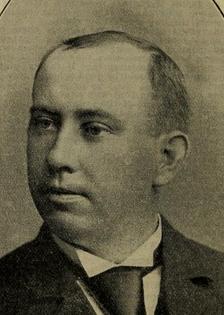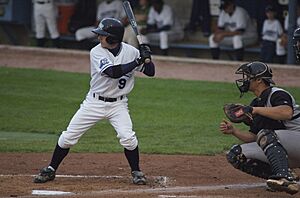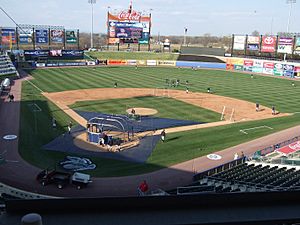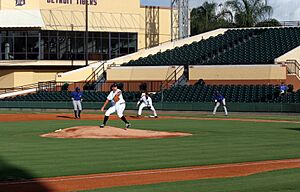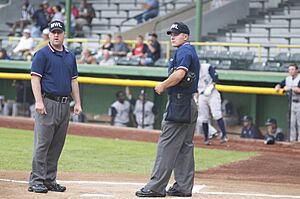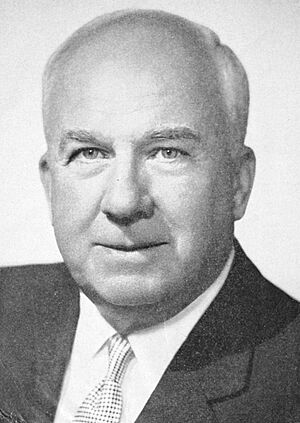Minor League Baseball facts for kids
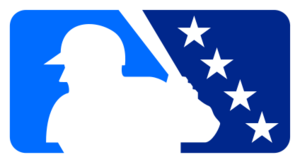 |
|
| Sport | Baseball |
|---|---|
| Founded | September 5, 1901 |
| No. of teams | 208 |
| Countries | United States (157 teams) Canada (1 team) + Dominican Republic (Rookie League) (50 teams) (as of 2024 season) |
| Headquarters | New York City, U.S. |
| TV partner(s) | Stadium, Bally Live App MiLB.tv, local tv stations |
| Official website | MiLB.com |
Minor League Baseball (often called MiLB) is a group of professional baseball teams. These teams are connected to clubs in Major League Baseball (MLB). MiLB helps young players develop their skills. It was started on September 5, 1901. Back then, it was called the National Association of Professional Baseball Leagues (NAPBL).
Minor League Baseball began as a way to organize smaller baseball teams. These teams didn't have as much money as the big leagues. For many years, minor leagues were independent. They had agreements with MLB teams. These agreements made sure they got paid when their players moved to the major leagues. Over time, MiLB became a system where all teams are connected to MLB clubs. This system helps young players get ready for the big leagues.
MiLB teams sign special agreements with MLB clubs. These agreements mean the MLB team pays for the players and staff. In return, the MLB team controls the players. They can move players between different levels of play.
Minor League Baseball has several levels. Players usually start at the lowest level. Then, they try to move up to higher levels. There are no strict rules for moving up. Some players might skip levels. Some might even go straight to the major leagues. MiLB's levels have changed many times. In 2021, some levels were removed. Today, the five main levels in the U.S. are: Rookie League, Single-A, High-A, AA (Double-A), and AAA (Triple-A). The Dominican Summer League is also part of MiLB.
In 2021, MLB made big changes to MiLB. The total number of teams was reduced to 120. Each of the 30 MLB teams now has four affiliated teams. There are also two Rookie leagues in the U.S. These teams play at their parent clubs' spring training sites. There is also a Rookie league in the Dominican Republic. Four independent baseball leagues are now partners with MLB. These teams are not directly connected to MLB clubs.
Contents
- Baseball's Early Days
- How Leagues Are Classified
- How Minor League Baseball Works
- Leagues and Connections
- Players in Minor League Baseball
- Umpires in Minor League Baseball
- Team Ownership
- Minor League Presidents
- Independent Baseball Leagues
- Awards in Minor League Baseball
- Broadcasting Games
- More to Explore
- See also
Baseball's Early Days

The very first professional baseball league was the National Association of Professional Base Ball Players (1871-1875). All teams in this league were professional. But it was hard to keep things fair. Teams often ran out of money during the season. So, the National League (NL) started in 1876. It only included the strongest teams. Other professional clubs then formed their own regional groups. These were loose groups that played for a championship.
The first real minor league was the Northwestern League (1883-1884). It was meant to be a lasting organization. It also joined an agreement with the NL and the American Association. This agreement protected players' contracts. It also set different pay levels for players. This helped create the idea of major and minor leagues. More minor leagues joined similar agreements over the next 20 years.
In the late 1890s, the Western League decided to challenge the NL. In 1900, it changed its name to the American League (AL). The AL started signing players who were unhappy with the NL. This caused a big fight between the two leagues. Minor league owners worried this fight would hurt their teams. So, on September 5, 1901, minor league leaders met in Chicago. They decided to form the National Association of Professional Baseball Leagues (NAPBL). This group later became Minor League Baseball. Their goal was to keep minor leagues independent. Patrick T. Powers became the first president of the NAPBL.
How Major and Minor Leagues Teamed Up
In 1903, the fight between the AL and NL ended. They created the National Baseball Commission to oversee all leagues. The NAPBL helped create rules for how major leagues could get players from minor leagues. This agreement made sure minor league teams got paid for players they helped develop. Most minor league teams sold their players because the money was important. Minor leagues were still very independent. Many people didn't even call them "minor." They saw themselves as separate businesses. Some minor league players were considered as good as major league players.
The relationship between minor and major leagues was tested by the Federal League. This new league tried to compete with the major leagues. It often took players from minor league teams. Some minor league teams thought about joining the Federal League. But the Federal League closed down in 1915.
The relationship was questioned again after World War I. In 1918, many minor leagues shortened their seasons. Players left to fight in the war. The major leagues also struggled with player shortages. So, the Commission allowed major leagues to sign minor league players temporarily.
After the 1918 season, there was a disagreement about player rights. Major league clubs claimed ownership of players they had signed temporarily. But their old minor league clubs still claimed control. This caused problems and hurt trust in the Commission. This led to the Commission being replaced by the Commissioner of Baseball.
The Farm System Begins
In 1921, Major League Baseball and Minor League Baseball made a new agreement. It allowed Major League teams to own Minor League teams. St. Louis Cardinals executive Branch Rickey used this to create a "farm system." He bought smaller clubs. He used them to train young players before they joined the Cardinals. Commissioner Kenesaw Mountain Landis didn't like this idea at first. But the Great Depression made it hard for many minor league teams to survive. So, they needed help from MLB teams. This is how minor leagues became connected to major leagues. Except for the Pacific Coast League (PCL), most minor leagues became financially dependent on MLB.
A 1922 Supreme Court decision helped MLB control minor leagues. This decision said baseball was special and didn't have to follow certain business laws. This meant MLB could set rules for all independent leagues. By 1925, MLB set a fixed price of $5,000 for any player from a minor league team. This rule hurt teams like the Baltimore Orioles. They used to keep players longer to develop them. This made the players more valuable. But with the fixed price, minor league teams had to sell players as soon as MLB showed interest.
Challenges to the Farm System
Even though MLB had a lot of control, some people resisted the farm system. Commissioner Kenesaw Mountain Landis didn't like major league teams owning farm teams. He often let players become free agents if he felt the farm system was being unfair. For example, in 1930, he freed Fred Bennett. Bennett had been sent to a farm team for three years in a row. Landis saw this as unfair to the player. This led to legal fights. Later, rules were changed to limit how major league clubs could send players to the minors.
Landis kept trying to limit MLB's control. In 1938, he investigated six teams in the St. Louis farm system. He freed 74 players and fined the Cardinals. He said the teams were just "add-ons" to the St. Louis system. In 1939, he freed 90 Detroit Tigers minor leaguers for similar reasons.
After World War II
Minor League Baseball became very popular after World War II. In 1949, there were 448 teams in 59 leagues. They played in Canada, Mexico, and the U.S. That year, 39 million people watched minor league games. But then, television became popular. Many fans started watching major league teams instead. Minor league teams had the right to stop MLB games from being shown on TV in their area. But they worried about losing money. So, MiLB agreed to let MLB games air on TV. In return, they got a share of TV profits and financial help.
In 1962, MLB and MiLB made an agreement that ended minor league independence. Major league clubs would sign "player development contracts" (PDCs) with minor league teams. This meant the MLB club would provide all the players and pay their salaries. In return, the MLB club had full control over the players. Today, almost every MiLB team must have a major league affiliate.
Minor League Baseball's popularity grew again in the 1990s and 2000s. It reached a new high of 41.6 million fans in 2009. In 2021, MiLB became much smaller. MLB cut ties with almost a quarter of all MiLB clubs. Several minor league levels were also removed.
How Leagues Are Classified
Old Classifications
The first ways to classify minor leagues started around 1890. These levels showed how much protection a player's contract had:
- Class A: Contracts and player lists were fully protected.
- Class B: Contracts were protected, but a major league team could draft a player for a set price.
- Class C: Contracts were protected.
- Class D: Contracts were protected, but any higher class could draft a player for a set price.
- Class E/F: No protection.
After the National Association of Professional Baseball Leagues started in 1901, the classifications changed:
| Class | City Population (in league) |
Monthly Salary Cap (team / player) |
Draft Fee |
Protection Fee |
|---|---|---|---|---|
| Class A | more than 1 million | $1800 / $175 | n/a | $50 |
| Class B | 400,001 to 1 million | $1000 / $125 | $300 | $30 |
| Class C | 200,001 to 400,000 | $800 / $100 | $200 | $20 |
| Class D | up to 200,000 | $700 / $75 | $100 | $10 |
![]() A draft fee was the amount a higher-class team paid to pick a player. Class A had no fee because they negotiated directly with major league clubs.
A draft fee was the amount a higher-class team paid to pick a player. Class A had no fee because they negotiated directly with major league clubs.
![]() A protection fee kept a player with a team even after their contract ended.
A protection fee kept a player with a team even after their contract ended.
All minor leagues were given a class. For example, in 1902:
- Class A: Eastern League, Western League
- Class B: Connecticut State League, New England League, New York State League, Pacific Northwest League, Southern League, Three-I League
- Class C: No league until 1903
- Class D: Cotton States League, Iowa–South Dakota League, Missouri Valley League, North Carolina League, Pennsylvania State League, Texas League
More classes were added before World War II:
- Class AA ("Double-A"): Added in 1912 as the highest level until 1945.
- Class A1: Added in 1936, between Class A and Class AA.
- Class E: Added in 1937 as the lowest level.
Changes After the War

In 1946, minor league baseball was growing fast. The higher-level classes changed. Class AAA ("Triple-A") was created. The three Double-A leagues became Triple-A. Class A1 became Class AA. Class A was still the third highest. Lower levels were Class B through Class D. Class D was like today's Rookie leagues. The Korean War in 1950 caused a shortage of players.
In 1952, the "Open" classification was created. The Pacific Coast League (PCL) was the only league to get this. It lasted until 1957. At that time, major league teams were not in the far west. The "Open" class limited how major leagues could draft PCL players. It seemed like the PCL might become a third major league. But the PCL went back to Triple-A in 1958. This was because more major league games were on TV. Also, the Dodgers and Giants moved to California.
Big Changes in 1963
Minor League Baseball changed a lot in 1963. Many clubs and leagues had closed down. In 1949, there were 448 minor league teams. By the end of 1963, only 15 leagues above Rookie-level were left in the U.S. and Canada.
After the 1962 season, the Triple-A American Association closed. Its remaining teams joined the International and Pacific Coast leagues. At the Double-A level and below, there were even bigger changes:
- The two Class A leagues became Double-A.
- Many Class B, C, and D leagues became Class A.
- The Class D Appalachian League became a new Rookie league.
The lower classes (B, C, D) disappeared. Minor league baseball was losing money. This was partly because major league games were shown on TV. As part of the 1963 changes, Major League clubs agreed to support minor league teams more. They did this through Player Development Contracts.
Changes from 1963 to 2021
The minor league system stayed mostly the same until 2020. Leagues were in six classes: Triple-A (AAA), Double-A (AA), Class A-Advanced (High A or A+), Class A (Low A), Class A Short Season, and Rookie. Rookie was also split into Rookie Advanced, complex-based Rookie, and international summer baseball.
- Triple-A: The American Association came back as a Triple-A league in 1969. It did well in the 1980s and 1990s. But in 1998, its teams joined the International and Pacific Coast leagues again. The Mexican League became Triple-A in 1967.
- Double-A: In 1964, the South Atlantic League changed its name to the Southern League. In 1971, the Texas League and Southern League briefly joined together.
- Class A: In 1980, the Western Carolinas League became the South Atlantic ("Sally") League again. Two more classes grew from Class A:
* Class A Short Season leagues started in 1965. They played shorter seasons (about 75-80 games). This allowed college players to finish school, get drafted, and then play right away. This class was removed before the 2021 season. * The Class A-Advanced class was added in 1990. It was one step below Double-A. In 2021, three new "High-A" leagues replaced the old ones.
- Rookie Advanced: The Appalachian League and Pioneer League became Rookie Advanced leagues in 1991. Players here were considered more developed than in pure Rookie leagues. This class was removed before the 2021 season.
- Rookie: In 1964, the Pioneer League became a Rookie league. The first "complex-based" leagues started. These were the Sarasota Rookie League and the Cocoa Rookie League. Games were played at spring training sites. The Arizona League started in 1989.
Some new leagues tried to start but failed. These were independent leagues not connected to MLB. None lasted more than one season.
Changes in 2021
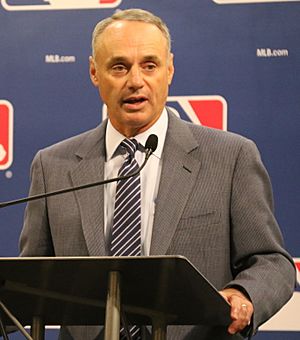
In late 2019, there were talks about big changes to MiLB. This included getting rid of many minor league teams. Many people, including members of the United States Congress, were against this idea. They said it would "devastate our communities." MLB said the changes would make things better for players.
On November 21, 2019, Minor League Baseball said it was "unnecessary and unacceptable to wipe out one-quarter of minor league teams." They said MLB wanted to make more money. MLB Commissioner Rob Manfred was upset that the talks were made public. He even threatened to cut ties with MiLB completely.
The following big changes happened:
- The Major League Baseball draft moved from June to July. It was also shortened from 40 rounds to 20.
- The Rookie-level Appalachian League became a summer league for college players.
- Several independent leagues became MLB Partner Leagues. This means MLB clubs can get players from them.
- The MLB Draft League was formed. It's a league for college players who might be drafted.
- Three independent league teams joined MiLB. The St. Paul Saints, Sugar Land Skeeters, and Somerset Patriots became MLB affiliates.
- The number of MiLB teams was cut from 160 to 120. Short-Season A and Rookie Advanced leagues were removed.
- The New York–Penn League was shut down.
- New Teams and Leagues for 2021
When MLB teams announced their affiliates for 2021, each of the 30 MLB teams had one team at four levels: Triple-A, Double-A, High-A, and Low-A. This made 120 total affiliated teams. 43 teams lost their MLB connections. The Fresno Grizzlies moved from Triple-A to Low-A. Many other teams swapped levels.
- League Name Changes
On February 12, 2021, Major League Baseball announced new league names. They used class and region-based names instead of the old historic names.
- Triple-A was split into Triple-A East and Triple-A West.
- Double-A was split into Double-A Central, Double-A Northeast, and Double-A South.
- High-A was split into High-A Central, High-A East, and High-A West.
- Low-A was split into Low-A East, Low-A Southeast, and Low-A West.
- The U.S.-based Rookie leagues were renamed the Florida Complex League and the Arizona Complex League.
On March 16, 2022, Minor League Baseball announced that the historic league names were brought back. The region-based names were removed. The old league names were given to the new leagues that were most similar.
- Triple-A East became the International League.
- Triple-A West became the Pacific Coast League.
- Double-A Central became the Texas League.
- Double-A Northeast became the Eastern League.
- Double-A South became the Southern League.
- High-A Central became the Midwest League.
- High-A East became the South Atlantic League.
- High-A West became the Northwest League.
- Low-A East became the Carolina League.
- Low-A Southeast became the Florida State League.
- Low-A West became the California League.
The Low-A classification was also officially renamed Single-A.
How Minor League Baseball Works
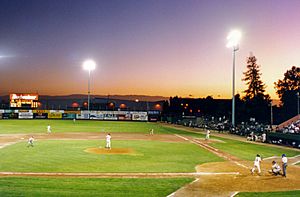

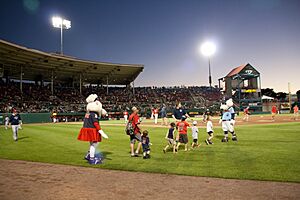
As of the 2022 season, the minor league system has four main classes: Triple-A (AAA), Double-A (AA), High-A (A+), and Single-A (A). Major League Baseball teams can also have one or two Rookie teams. These are based at their training complexes in Arizona or Florida. There are also international summer baseball teams in the Dominican Summer League. Major league teams play 162 games. Minor league seasons are shorter. In 2022, Triple-A played 150 games, Double-A played 138 games, and High-A and Single-A played 132 games. There is also the Arizona Fall League for top prospects.
Triple-A Teams
This is the highest level of Minor League Baseball. It has two leagues: the 20-team International League and the 10-team Pacific Coast League. The International League has teams from the Atlantic coast and Midwest U.S. The Pacific Coast League has teams from the Pacific coast and Southwest.
Both young players and experienced players play in Triple-A. MLB teams often keep players here who are on their 40-man roster. These players can be called up to the major league team at any time. This helps major league teams get fresh players late in the season. Some Triple-A players are "career minor leaguers." They are good players but might not make it to MLB full-time.
Double-A Teams
There are three leagues at this level: the 12-team Eastern League (Northeast and Mid-Atlantic U.S.), the eight-team Southern League (Deep South), and the 10-team Texas League (Southwest and Great Plains).
Some players can jump straight from Double-A to the major leagues. Many top young players are placed here to play against each other. A few experienced players from other countries might start here. These players are usually expected to reach the majors quickly.
High-A Teams
This level is one step below Double-A. It was called "Class A-Advanced" before 2021. It has three leagues: the 12-team Midwest League (Midwest), the six-team Northwest League (Pacific Northwest), and the 12-team South Atlantic League (eastern states). All three leagues changed classifications in 2021.
Players at this level are often on their second or third promotion. Some top players drafted from college might start here.
Single-A Teams
Below High-A is Single-A. It was called "Class A" before 2021. It was also known as "Low-A" in 2021. This class has three leagues: the 8-team California League (California), the 12-team Carolina League, and the 10-team Florida State League. All three leagues moved down from High-A in 2021.
These leagues have a mix of players from Rookie leagues and some experienced first-year players. Many teams in the Florida State League are owned by major league clubs. They use their spring training facilities.
In 2022, the official name of this class became Single-A.
Rookie Teams
Rookie leagues play a shorter season. It usually starts in mid-June and ends in late August or early September. This is the lowest level of minor league baseball. It has two U.S.-based leagues: the Arizona Complex League and Florida Complex League. It also has one league in the Caribbean: the Dominican Summer League.
The U.S.-based Rookie leagues play about 60 games. They are called "complex leagues" because games are played at the parent clubs' spring training sites. Most players here are newly drafted. They are not yet ready for higher levels. These leagues are mainly for players to improve their skills. No admission is charged, and no food is sold.
As of the 2024 season, the Arizona Complex League and Florida Complex League start in early May. They finish in late July. This lets players with experience in the Dominican Summer League play a full season in the U.S. It also means top Rookie players can move up to Single-A later in the season.
Team Sizes and Player Rules
As of the 2024 season, each major league club can have up to 165 players on their domestic minor league teams. This does not include international players or players on injured lists. During the offseason, the limit is 175 domestic players. During the season, here are the roster limits for each level:
| Level | Active Roster Size | Player Restrictions |
|---|---|---|
| Triple-A | 28 players | No restrictions |
| Double-A | 28 players | No restrictions |
| High-A | 30 players | No more than 2 players and 1 player-coach with 6 or more years of minor-league experience |
| Single-A | 30 players | No more than 2 players with 5 or more years of minor-league experience |
| U.S.-based Rookie |
No limit | No more than 3 players with 4 or more years of minor-league experience |
| International Rookie |
35 players | No players with 4 or more years of minor-league experience |
Leagues and Connections
Minor Leagues You Can Find
Triple-A
Double-A
- Eastern League
- Southern League
- Texas League
High-A
- Midwest League
- Northwest League
- South Atlantic League
Single-A
- California League
- Carolina League
- Florida State League
Rookie
- Arizona Complex League
- Florida Complex League
- Dominican Summer League
Off-season leagues
- Arizona Fall League
Showcase league
- MLB Draft League
Partner leagues
- American Association
- Atlantic League
- Frontier League
- Pioneer League
Major League Team Connections
| Triple-A | Double-A | High-A | Single-A | ||||
|---|---|---|---|---|---|---|---|
| IL | International League | EL | Eastern League | MWL | Midwest League | CAL | California League |
| PCL | Pacific Coast League | SL | Southern League | NWL | Northwest League | CAR | Carolina League |
|
|
TL | Texas League | SAL | South Atlantic League | FSL | Florida State League | |
| League | Division | MLB Team | Triple-A | Double-A | High-A | Single-A |
|---|---|---|---|---|---|---|
| American League | East | Baltimore Orioles | Norfolk TidesIL | Chesapeake BaysoxEL | Aberdeen IronBirdsSAL | Delmarva ShorebirdsCAR |
| Boston Red Sox | Worcester Red SoxIL | Portland Sea DogsEL | Greenville DriveSAL | Salem Red SoxCAR | ||
| New York Yankees | Scranton/Wilkes-Barre RailRidersIL | Somerset PatriotsEL | Hudson Valley RenegadesSAL | Tampa TarponsFSL | ||
| Tampa Bay Rays | Durham BullsIL | Montgomery BiscuitsSL | Bowling Green Hot RodsSAL | Charleston RiverDogsCAR | ||
| Toronto Blue Jays | Buffalo BisonsIL | New Hampshire Fisher CatsEL | Vancouver CanadiansNWL | Dunedin Blue JaysFSL | ||
| Central | Chicago White Sox | Charlotte KnightsIL | Birmingham BaronsSL | Winston-Salem DashSAL | Kannapolis Cannon BallersCAR | |
| Cleveland Guardians | Columbus ClippersIL | Akron RubberDucksEL | Lake County CaptainsMWL | Lynchburg HillcatsCAR | ||
| Detroit Tigers | Toledo Mud HensIL | Erie SeaWolvesEL | West Michigan WhitecapsMWL | Lakeland Flying TigersFSL | ||
| Kansas City Royals | Omaha Storm ChasersIL | Northwest Arkansas NaturalsTL | Quad Cities River BanditsMWL | Columbia FirefliesCAR | ||
| Minnesota Twins | St. Paul SaintsIL | Wichita Wind SurgeTL | Cedar Rapids KernelsMWL | Fort Myers Mighty MusselsFSL | ||
| West | Houston Astros | Sugar Land Space CowboysPCL | Corpus Christi HooksTL | Asheville TouristsSAL | Fayetteville WoodpeckersCAR | |
| Los Angeles Angels | Salt Lake BeesPCL | Rocket City Trash PandasSL | Tri-City Dust DevilsNWL | Inland Empire 66ersCAL | ||
| Athletics | Las Vegas AviatorsPCL | Midland RockHoundsTL | Lansing LugnutsMWL | Stockton PortsCAL | ||
| Seattle Mariners | Tacoma RainiersPCL | Arkansas TravelersTL | Everett AquaSoxNWL | Modesto NutsCAL | ||
| Texas Rangers | Round Rock ExpressPCL | Frisco RoughRidersTL | Hub City SpartanburgersSAL | Hickory CrawdadsCAR | ||
| National League | East | Atlanta Braves | Gwinnett StripersIL | Columbus ClingstonesSL | Rome EmperorsSAL | Augusta GreenJacketsCAR |
| Miami Marlins | Jacksonville Jumbo ShrimpIL | Pensacola Blue WahoosSL | Beloit Sky CarpMWL | Jupiter HammerheadsFSL | ||
| New York Mets | Syracuse MetsIL | Binghamton Rumble PoniesEL | Brooklyn CyclonesSAL | St. Lucie MetsFSL | ||
| Philadelphia Phillies | Lehigh Valley IronPigsIL | Reading Fightin PhilsEL | Jersey Shore BlueClawsSAL | Clearwater ThreshersFSL | ||
| Washington Nationals | Rochester Red WingsIL | Harrisburg SenatorsEL | Wilmington Blue RocksSAL | Fredericksburg NationalsCAR | ||
| Central | Chicago Cubs | Iowa CubsIL | Knoxville SmokiesSL | South Bend CubsMWL | Myrtle Beach PelicansCAR | |
| Cincinnati Reds | Louisville BatsIL | Chattanooga LookoutsSL | Dayton DragonsMWL | Daytona TortugasFSL | ||
| Milwaukee Brewers | Nashville SoundsIL | Biloxi ShuckersSL | Wisconsin Timber RattlersMWL | Carolina MudcatsCAR | ||
| Pittsburgh Pirates | Indianapolis IndiansIL | Altoona CurveEL | Greensboro GrasshoppersSAL | Bradenton MaraudersFSL | ||
| St. Louis Cardinals | Memphis RedbirdsIL | Springfield CardinalsTL | Peoria ChiefsMWL | Palm Beach CardinalsFSL | ||
| West | Arizona Diamondbacks | Reno AcesPCL | Amarillo Sod PoodlesTL | Hillsboro HopsNWL | Visalia RawhideCAL | |
| Colorado Rockies | Albuquerque IsotopesPCL | Hartford Yard GoatsEL | Spokane IndiansNWL | Fresno GrizzliesCAL | ||
| Los Angeles Dodgers | Oklahoma City CometsPCL | Tulsa DrillersTL | Great Lakes LoonsMWL | Rancho Cucamonga QuakesCAL | ||
| San Diego Padres | El Paso ChihuahuasPCL | San Antonio MissionsTL | Fort Wayne TinCapsMWL | Lake Elsinore StormCAL | ||
| San Francisco Giants | Sacramento River CatsPCL | Richmond Flying SquirrelsEL | Eugene EmeraldsNWL | San Jose GiantsCAL |
Map of Teams
Player Rosters
How Classes Changed Over Time
This table shows how minor league classes have changed since 1902. New classes are in bold, and removed classes are in italics.
| 1902 | 1912 | 1936 | 1937 | 1946 | 1952 | 1958 | 1963 | 1965 | 1990 | 1991 | 2021 |
|---|---|---|---|---|---|---|---|---|---|---|---|
|
|
|
|
|
|
|
|
|
|
|
|
|
|
|
|
Notes:
- High-A was formerly Class A-Advanced (A-Adv) before 2021.
- Class A was officially known as Low-A during the 2021 season.
- A (Short) means Class A Short Season.
- Rk-Adv means Rookie Advanced.
- Rk means Rookie.
Players in Minor League Baseball
Major league teams can only use players who are on their active roster for games. These players are chosen from a larger list of 40 players. Since the 2020 season, the active roster size is 26 players for most games. It expands to 28 players from September 1 until the end of the season.
Players on the 40-man list who are not on the active roster are usually either injured or playing in the minor leagues. Most of these players are at the Triple-A or Double-A level. Before 2022, only players on the 40-man list could join the players' union. But in September 2022, most minor league players voted to join the union.
A major league team's player development director decides where a player will play. They work with coaches who evaluate talent. After spring training, players are assigned to a minor league team. New players drafted in June usually start playing professionally then. The farm system is always changing. Player evaluation is a constant process. The director and managers regularly talk about how players are doing. Player improvement, injuries, and good performance by players at lower levels all affect a player's movement.
Players usually stay with their assigned team for the season. But they can be "called up" (promoted), "sent down" (moved to a lower team), or released. Being released used to mean the end of a minor league player's career. But now, released players often sign with independent baseball clubs. Major league teams watch these independent leagues closely. Many players get another chance if they improve there.
Player Pay and Benefits
Minor league players are professional athletes. Usually, the major league club pays the players and coaches. They also provide bats and balls. The minor league club pays for travel during the season and other costs.
Minor league salaries depend on the level and contract type. Minor league players with major league experience or on an MLB team's 40-man roster get paid more. They also follow all MLB player rules. Minor league players not on the 40-man list are paid less. They work to improve their skills and move up. Many players get signing bonuses, especially early-round draft picks. Before 2022, most MiLB players made less than $10,000 per season. After new talks and the unionization of MiLB players, minor leaguers received much higher salaries and benefits.
| Level | Minimum annual salary | Minimum annual salary if on 40-man roster |
Minimum annual salary with MLB experience |
|---|---|---|---|
| Triple-A | $35,800 | $60,300 | $120,600 |
| Double-A | $30,250 | ||
| High-A | $27,300 | ||
| Single-A | $26,200 | ||
| US-based Rookie | $19,800 | ||
| Arizona Fall League | $6,000 | ||
| Foreign-based Rookie | $3,000 |
Coming Back from Injuries
When Major League players get injured, they often play for minor league teams to get back in shape. This is called a "rehabilitation assignment."
Players on the injured list (IL) can be sent to the minor leagues. This helps them recover after an injury. They usually stay for one or two weeks. Players are often sent to minor league clubs based on where they are located and their facilities. The class level doesn't always matter for these assignments.
Major league players on rehab assignments still get their major league pay. They also often have better facilities than their minor league teammates.
For example, Joe Mauer of the Minnesota Twins had knee surgery in 2010. He missed the start of the 2011 season. He played for the Twins' Class A-Advanced team, the Fort Myers Miracle, to get ready. The Miracle manager was his older brother, Jake.
Mike Trout's first rehab assignment was in July 2017. He played for the Inland Empire 66ers. This team is the Class A-Advanced affiliate of the Los Angeles Angels. This allowed Trout to stay closer to the Angels' main team.
Umpires in Minor League Baseball
Umpires in the minor leagues are managed by Minor League Baseball Umpire Development (MiLBUD). This group trains and evaluates umpires. They also decide who gets promoted or released.
Umpires are evaluated eight times a season. They get a ranking at mid-season and at the end of the year. If they do well, they might move up to a higher class. MiLBUD holds a Rookie Evaluation Course every March. This course evaluates new umpires. The best students from professional umpire schools usually attend. Those who pass are recommended for openings in lower-level leagues.
Anyone who wants to be a professional umpire must go to a special training school. Minor League Baseball recognizes two schools in Florida: the Harry Wendelstedt Umpire School and the Minor League Baseball Umpire Training Academy. The Umpire Training Academy is owned by MiLBUD. The Wendelstedt Umpire School is independent. Classes are held for five weeks in January and February. The teachers are current or former major or minor league umpires. But going to a school doesn't guarantee a job. Usually, less than 20% of students move on to the evaluation course.
Before this program, minor league presidents hired umpires directly. Umpires were "sold" from league to league by word of mouth. The umpire development program started in 1964. It was created to find, train, and develop umpires for both major and minor leagues. The program aimed to find more athletic and dedicated people. In 1968, they decided to have their own training course every year. The first course was held in St. Petersburg, Florida, in 1969.
Minor league umpires have had a union since 1999. They formed the Association of Minor League Umpires (AMLU). In 2006, they went on strike action because of a disagreement over salaries. Replacement umpires were used until an agreement was reached after two months.
To be a professional umpire, you need a high school diploma or a G.E.D. You must be athletic and have good eyesight (20/20 vision). Glasses or contact lenses are allowed. You also need good communication skills, reflexes, and coordination. And you must have trained at one of the two professional umpire schools.
Team Ownership

Most minor league teams are owned and run independently. They are connected to one major league team. These connections are set by agreements called Player Development License Agreements (PDL). Some minor league teams are owned directly by their major league parent club. As of January 2025, 41 of the 120 teams are owned by one company, Diamond Baseball Holdings. This company started in 2021. MLB has rules about how many teams one company can own.
Since the 2021 changes, affiliation agreements usually last 10 years. Before, they were only for two or four years. So, teams changed affiliations often. But many relationships have lasted a long time. For example, the Omaha Storm Chasers have been connected to the Kansas City Royals since 1969. But the Columbus Clippers changed affiliations several times.
The longest continuous affiliations are between the Philadelphia Phillies and their Double-A team, the Reading Fightin Phils. Also, between the Detroit Tigers and their Single-A team, the Lakeland Flying Tigers. Both of these started in 1965. Both Reading and Lakeland are now owned by their major league clubs.
Minor League Presidents
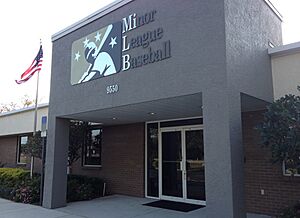
Minor League Baseball used to have a central office. But after the 2021 changes, Major League Baseball now handles most of the management. Minor league headquarters were in St. Petersburg, Florida, from 1973. Before MLB took direct control, 11 people served as president of Minor League Baseball:
- Patrick T. Powers, 1901–1909
- Michael H. Sexton, 1910–1932
- William G. Bramham, 1933–1946
- George Trautman, 1947–1963
- Phil Piton, 1964–1971
- Hank Peters, 1972–1975
- Bobby Bragan, 1976–1978
- John H. Johnson, 1979–1988
- Sal Artiaga, 1988–1991
- Mike Moore, 1992–2007
- Pat O'Conner, 2007–2020
Independent Baseball Leagues
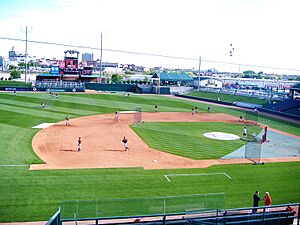
Independent leagues are professional baseball leagues in the U.S. and Canada. They are not part of Minor League Baseball or controlled by the Commissioner of Baseball. Independent baseball existed in the early 1900s. It has become popular again since 1993.
Before 1902, most leagues operated on their own. Then, most joined the NAPBL. From then until 1915, a few leagues stayed independent. Most joined the National Association later. A notable independent league was the Federal League. It played at a major league level from 1914 to 1915.
Few independent leagues existed between 1915 and 1993. The Carolina League was known as an "outlaw league." The Provincial League in Quebec was also independent for a time. Like earlier independent leagues, it later joined the National Association.
Independent leagues grew again after 1992. This was because new rules made it harder for teams to be part of organized baseball. Over the next eight years, at least 16 independent leagues formed. As of the 2025 season, there are seven active independent leagues. Four of them are now MLB Partner Leagues.
Awards in Minor League Baseball
MiLBY Awards
The MiLBY Awards are given in nine categories. For five categories (Best Starter, Best Hitter, Best Reliever, Best Game, and Best Team), winners are chosen at each minor league level above Rookie. For three categories (Play of the Year, Moment of the Year, and Homer of the Year), one overall winner is chosen for all of Minor League Baseball. For the "Promo of the Year" category, there are overall winners in five subcategories: Best Promotion, Best Theme Night, Best Giveaway, Best Celebrity Appearance, and Best Miscellaneous Promotion.
Other Player Awards
- MiLB Topps Minor League Player of the Year Award – started in 1960; last given in 2013.
- MiLB George M. Trautman Awards – Topps Player of the Year in each domestic minor league.
- MiLB Joe Bauman Home Run Award – given since 2002.
- Baseball America Minor League Player of the Year Award – given since 1981.
- The Sporting News Minor League Player of the Year Award – given from 1936–2007.
- USA Today Minor League Player of the Year Award – given since 1988.
Major Awards
- Organization of the Year Award (formerly the John H. Johnson President's Award) (1974) – MiLB's top award. It recognizes a team for stability, community contributions, and promoting baseball.
- Rawlings Woman Executive of the Year (1976) – given to a woman in MiLB for great contributions to her club, league, or baseball.
- Warren Giles Award (1984) – given to a league president for excellent service.
- King of Baseball (1951) – given each year for long-time dedication to professional baseball.
- Larry MacPhail Award (1966–2019) – given each year for team promotions.
- Sheldon "Chief" Bender Award (2008) – given to someone who has helped players develop.
- Mike Coolbaugh Award (2008) – given to someone who shows a great work ethic, baseball knowledge, and helps mentor young players.
- John H. Moss Community Service Award (2013) – given to a team for outstanding charity work and community leadership.
- Charles K. Murphy Patriot Award (2016) – given to a person or team for great support of the United States Armed Forces and veterans.
Broadcasting Games
Radio
Almost every minor league team has its own local radio contract. Unlike major league teams, these usually involve only one or two stations.
Television
Nationally, Minor League Baseball games are shown on Stadium and MLB Network.
Many individual teams also have deals with local TV channels. For example, the Triple-A Indianapolis Indians had a contract with WISH-TV to show 35 home games in 2021.
Streaming Online
MiLB.TV is the minor leagues' online video streaming service. It's like Major League Baseball's MLB.tv. Since the 2021 season, you can subscribe to watch games for all Triple-A and Double-A teams. Some games from other levels are also available. All games can also be streamed for free on the Bally Live App.
TuneIn has offered free audio streams for minor league games. You can find these on the MiLB.TV website.
More to Explore
- History of baseball
- The Official Professional Baseball Rules Book
- Independent baseball league
- Korea Baseball Futures League
- Eastern League and Western League of Japan
See also
 In Spanish: Ligas Menores de Béisbol para niños
In Spanish: Ligas Menores de Béisbol para niños



